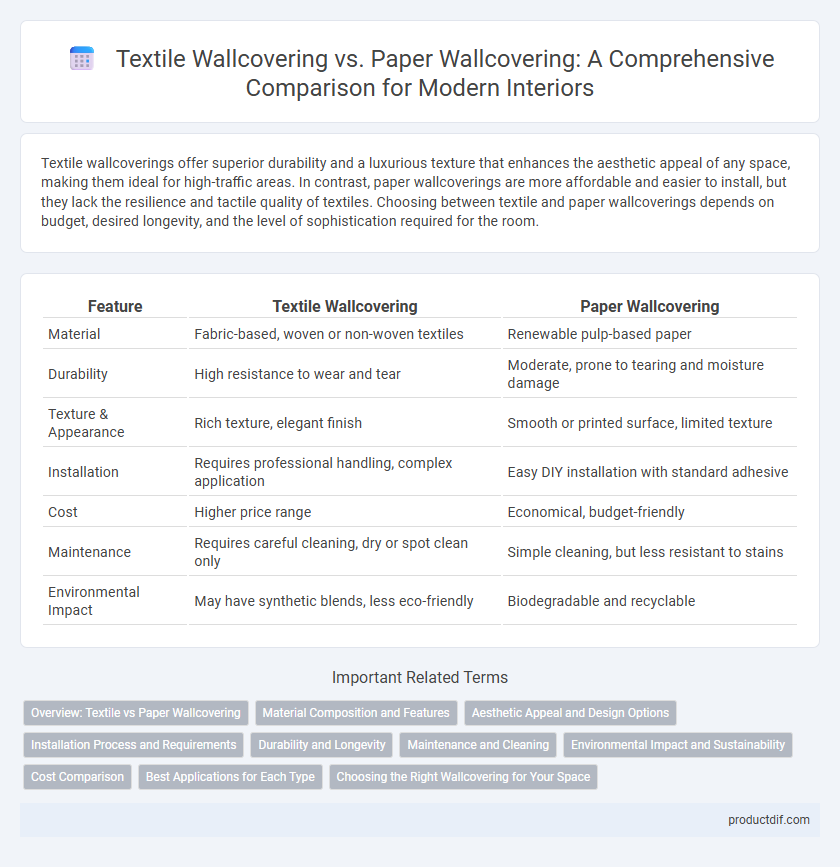Textile wallcoverings offer superior durability and a luxurious texture that enhances the aesthetic appeal of any space, making them ideal for high-traffic areas. In contrast, paper wallcoverings are more affordable and easier to install, but they lack the resilience and tactile quality of textiles. Choosing between textile and paper wallcoverings depends on budget, desired longevity, and the level of sophistication required for the room.
Table of Comparison
| Feature | Textile Wallcovering | Paper Wallcovering |
|---|---|---|
| Material | Fabric-based, woven or non-woven textiles | Renewable pulp-based paper |
| Durability | High resistance to wear and tear | Moderate, prone to tearing and moisture damage |
| Texture & Appearance | Rich texture, elegant finish | Smooth or printed surface, limited texture |
| Installation | Requires professional handling, complex application | Easy DIY installation with standard adhesive |
| Cost | Higher price range | Economical, budget-friendly |
| Maintenance | Requires careful cleaning, dry or spot clean only | Simple cleaning, but less resistant to stains |
| Environmental Impact | May have synthetic blends, less eco-friendly | Biodegradable and recyclable |
Overview: Textile vs Paper Wallcovering
Textile wallcoverings offer superior durability, texture, and acoustic benefits compared to paper wallcoverings, making them ideal for high-traffic or luxury spaces. Paper wallcoverings provide a budget-friendly and versatile option with a wide range of patterns and easy installation but tend to be less resistant to moisture and wear. Choosing between textile and paper wallcoverings depends on factors like room function, desired aesthetics, and maintenance requirements.
Material Composition and Features
Textile wallcoverings are made from natural or synthetic fibers like silk, cotton, or polyester, providing durability, texture, and a luxurious appearance ideal for high-traffic areas. Paper wallcoverings are composed of cellulose fibers, offering a lightweight, cost-effective option with easy installation but lower resistance to wear and moisture. Textile options often include added benefits such as sound insulation and enhanced aesthetics, whereas paper variants prioritize affordability and simplicity.
Aesthetic Appeal and Design Options
Textile wallcoverings offer a rich, luxurious texture and depth that enhance the aesthetic appeal of any space, providing a premium look unattainable with paper wallcoverings. They come in a variety of intricate weaves, patterns, and materials such as silk, linen, and cotton, allowing for greater design versatility and tactile interest. Paper wallcoverings, while generally more affordable and available in countless print designs and colors, lack the dimensionality and sophisticated finish that textile wallcoverings provide.
Installation Process and Requirements
Textile wallcoverings require specialized adhesive and precise handling due to their heavier weight and fabric texture, often necessitating professional installation to avoid wrinkles and bubbles. Paper wallcoverings are lighter and generally easier to install, using standard wallpaper paste and allowing DIY application with basic tools. Proper surface preparation is critical for both types to ensure long-lasting adhesion and a smooth finish.
Durability and Longevity
Textile wallcoverings offer superior durability compared to paper wallcoverings, resisting wear and tear in high-traffic areas and maintaining their appearance over time. Their fabric composition enables better resistance to fading, moisture, and impact damage, extending the lifespan of the wall treatment. Paper wallcoverings, while cost-effective, tend to be less resilient and may peel, tear, or discolor faster under similar conditions.
Maintenance and Cleaning
Textile wallcoverings offer superior durability and stain resistance compared to paper wallcoverings, making maintenance easier and less frequent. Their woven fibers allow for gentle vacuuming and spot cleaning without damaging the material, while paper wallcoverings require careful handling to avoid tearing and discoloration during cleaning. High-quality textile options often feature protective coatings that enhance their resistance to dirt and moisture, providing a longer-lasting clean appearance.
Environmental Impact and Sustainability
Textile wallcoverings generally have a higher environmental footprint due to energy-intensive manufacturing and synthetic fiber use, while paper wallcoverings often utilize recycled materials and offer easier recyclability. Natural fiber textile options like organic cotton or hemp can improve sustainability but still require more water and chemicals compared to paper-based alternatives. Choosing paper wallcoverings with eco-friendly inks and certifications such as FSC or PEFC supports reduced deforestation and lower emissions in interior design projects.
Cost Comparison
Textile wallcoverings generally cost significantly more than paper wallcoverings due to premium materials such as silk, linen, or cotton and higher manufacturing complexity. Paper wallcoverings are more budget-friendly, with prices typically ranging from $0.50 to $3 per square foot, while textile options can range from $10 to $30 or more per square foot. Maintenance and durability factors also influence long-term value, as textile wallcoverings often offer greater longevity but require specialized cleaning.
Best Applications for Each Type
Textile wallcoverings offer superior durability and texture, making them ideal for high-traffic areas and spaces requiring enhanced acoustic insulation, such as hotels and theaters. Paper wallcoverings excel in cost-effectiveness and ease of installation, suitable for residential rooms and short-term decorative projects. Choosing between textile and paper wallcoverings depends on factors like budget, desired lifespan, and the specific environmental needs of the space.
Choosing the Right Wallcovering for Your Space
Textile wallcoverings offer superior durability, texture, and acoustic benefits, making them ideal for high-traffic or elegant spaces requiring a sophisticated look and long-lasting finish. Paper wallcoverings provide cost-effective, easy-to-install solutions with a wide range of patterns suitable for temporary or low-traffic areas. Selecting the right wallcovering depends on your budget, desired aesthetic, maintenance tolerance, and functional needs of the room.
Textile Wallcovering vs Paper Wallcovering Infographic

 productdif.com
productdif.com